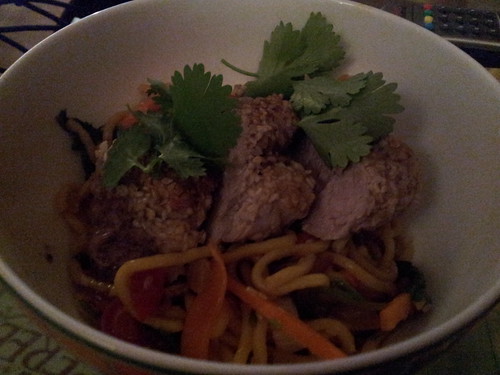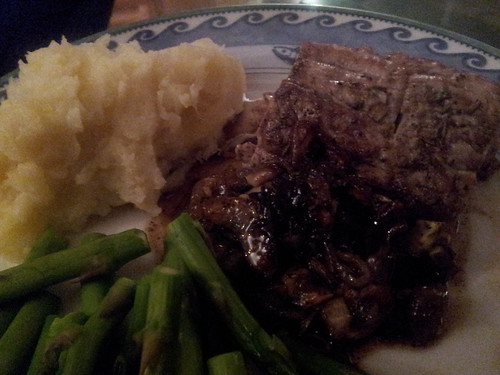Pork recipes are always hugely popular on Eating Adelaide for some reason. The most popular in the last month has been this super easy one pan pork fillet recipe. Today, let’s look at a slightly cheaper cut: the pork chop.
This is not so much a recipe, because all you do is pan fry the pork chop, but it’s more some ideas of what to serve with your pork chop to jazz it up a bit. I always remove the rind from the chops before frying: in the pan they never get crisp and it’s better to remove them, let them dry out in the fridge for a couple of days and throw them on the grill on the weekend when you do your bacon. Delicious!
In this meal, inspired by Delicious (UK), you serve your chop with polenta and gremolata. I added buttered spinach too, for some greens, but a salad would work well and give you a bit more vegetable variety.
For 2 people we find 100g of (quick cook) polenta, cooked with 400g of water, just a little too much. I always have plans to do something with it the next day (polenta crisps, Roman gnocchi) but it just never happens. But the rule is, four times as much water as polenta. Boil the polenta up on the stove, stirring it and keeping the heat under control. If it gets too hot, you’ll have little geysers of polenta exploding out of the pan and if one hits you, you’ll know all about it! HOT!
Cook the polenta until it’s done: and done is when it’s a silky consistency and it no longer feels grainy or gritty. I’ve never yet managed to overcook polenta and, if you find it’s ready a bit soon, you can turn off the heat because it reheats beautifully.
If you watched My Kitchen Rules last night, you’ll have heard Pete Evans mention that polenta needs seasoning. He is not wrong. Don’t be shy with the salt. At a minimum I add grated parmesan and salted butter to my polenta (both to taste or according to how much is actually left in the fridge!). If you have cream, or better yet, mascarpone, add this for beautiful silky smooth polenta. Seasoning is even more critical in a dish like this, where you don’t really have any sauce for the polenta to soak up. Taste as you go, and season by feel.
Gremolata is easy: chop parsely and add finely minced garlic, some chilli flakes and some grated lemon rind. Be careful with the garlic – as it’s not cooked it can easily become overpowering and hot, which is not what you want.
Serve the polenta on hot plates, top with a pork chop and sprinkle with gremolata. Serve extra gremolata on the side, along with some vegetables.
You’ll be able to do the polenta in the time it takes the pork chops to cook, which makes this dish extremely quick – as well as tasty and a pleasant change to a plain pork chop with salad.
Oh – and I’d recommend not serving it in a bowl. Because there’s no sauce you don’t have to worry about the polenta going sloppy and running everywhere and it can be tricky to cut a chop, and work your way around the bone, in a bowl!!!



